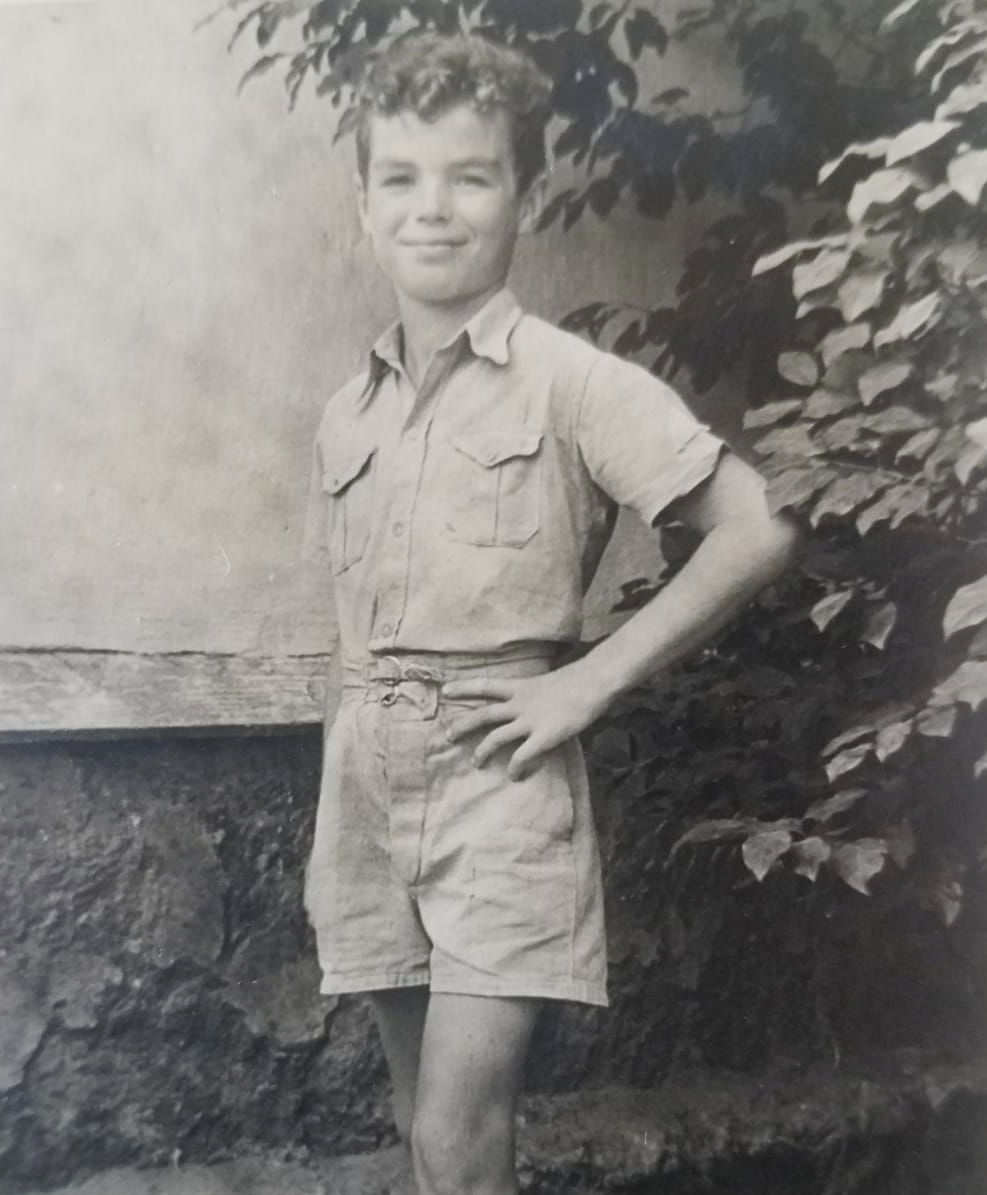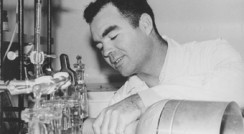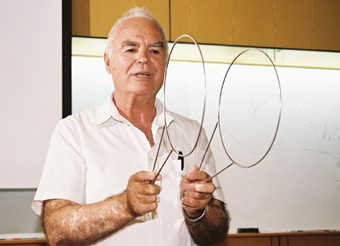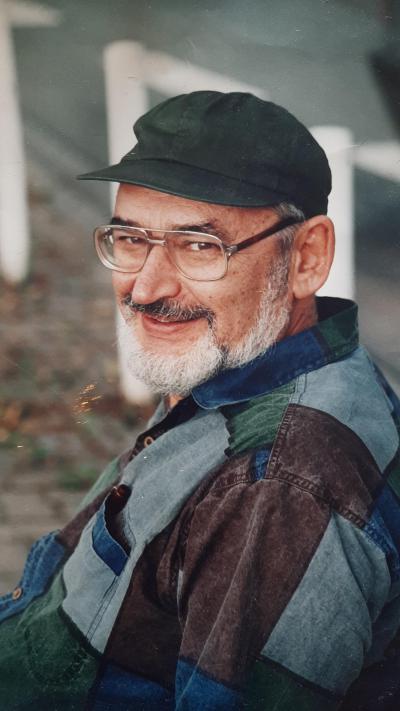Prof Shimon Vega
Prof Zeev Luz
Prof Anatoly Burshtein
Prof. Shimon Vega (1943-2021)

Shimon Vega was born in Amsterdam on November 14, 1943 and passed away two days after his 78th birthday. As he would later say: “This was not a good time and place for a Jewish child to be born, and led to what perhaps was the most ‘interesting’ part of my life”. At the age of 6 weeks he was sent to a hideout with a Dutch family until the end of the war, thus surviving the Holocaust. He grew up in Ouderkerk aan de Amstel, a small village south of Amsterdam. After obtaining both his B.Sc. and M.Sc. in Physics in Holland he moved to Israel with his wife Margrit, and completed his Ph.D. with Prof. Zeev Luz at the Weizmann Institute on Nuclear Quadrupole Resonance. Shimon stood out already during his PhD, where he published his thesis papers as a sole author with the full encouragement of his advisor. This work was the beginning of a joint tackling of the theoretical and experimental chemical physics underlying magnetic resonance. After PhD graduation Shimon became Alex Pines’ first postdoc at Berkeley, where they made pioneering discoveries in the new field of multiple-quantum NMR. This work would eventually lead to setting the basis for the fictitious-spin-½ formalism, nowadays a primary tool for understanding NMR in solids and liquids and gaining recognition in EPR and quantum optics.
Upon completing his postdoc Shimon returned as a tenure-track faculty to the Weizmann Institute, where he expanded these studies to half-integer quadrupolar nuclei. This work, along with the multi-quantum concept, served as basis for additional future developments in the field that resulted in a wide variety of materials-oriented research. Shimon continued to focus mostly on solids NMR and developed new decoupling and recoupling methods, as well as new kinds of pulses and new structural determination schemes –most often while relying on magic angle spinning (MAS). In those late-1970/early-1980 days, MAS was largely viewed from a continuous-wave perspective; i.e., as an averaging process leading to the cancelation of second-rank anisotropies and hence sharp spin-1/2 lines. Drawing from the time-domain perspective that had led to multiple-quantum NMR, Shimon departed from this outlook, and was among the first to recognize the complex time-dependencies that underlie MAS as an averaging process. Starting at Weizmann and furthering these ideas during sabbaticals at MIT with R.G. Griffin and at Washington University with J. Schaefer in the 1980s, Shimon thus developed sophisticated theories –many of them based on the Floquet formalism– to advance the understanding of MAS NMR. These efforts allowed exact computation of MAS spectra under a variety of scenarios, while leading to a deeper understanding and to new pulse sequences. They also lead to new methods to evaluate dynamic processes in MAS NMR, and to the design and interpretation of a variety of discrete multipulse recoupling experiments. The latter included homo- and hetero-nuclear dipolar decoupling/recoupling schemes like SEDRA, TEDOR, RFDR and REAPDOR, that have since become common tools in the biomolecular and materials NMR arsenal. They also included sensitivity enhancement schemes, such as the FAM sequence for semi integer quadrupolar nuclei. During a subsequent stage of Shimon’s solids NMR research he extended Floquet’s sophisticated formalism to a multimodal format, capable of accounting for the coherent evolution of a density matrix subject to multiple, non-commensurate time-dependent processes simultaneously. Numerous experiments he designed were on the basis of multi-modal Floquet theories, in particular the high resolution single- and multidimensional proton NMR phase-modulated Lee-Goldburg sequences (PMLGn).
During the last decade Shimon embarked on yet another venture: understanding the mechanism of dynamic nuclear polarization (DNP) at high magnetic fields. He realized the limitation of traditional steady-state descriptions of DNP, and developed instead quantum mechanical models which could reproduce and predict important experimental features – helping to bring about DNP MAS NMR’s renaissance. Shimon continued to be highly active and productive years after his “formal” retirement, and kept working on and thinking about magnetic resonance till the day he was hospitalized.
Shimon was truly exceptional as an educator and scholar, that molded and enriched the lives of those he met and interacted with. He was an engaging lecturer that would capture audiences, despite –and perhaps because of– his relentless refusal to escape from equations and meaningful concepts. He was a sought-after teacher that in addition to regular courses at the Weizmann Institute devoted ample time lecturing at high schools, guiding local kids in visits through the Weizmann labs, and sharing his science with his community –much before outreach activities became “fashionable”. Shimon was a remarkable mentor, who trained graduate students and postdoctoral fellows that are now leaders in the forefront of magnetic resonance worldwide. But more than anything else, Shimon was an exceptionally caring human being, who inspired with his generosity in sharing his knowledge and wisdom, his patience, his unusual capability to listen, and his modesty. At the Israel Chemical Society 2018 meeting, which endowed Shimon with its highest Gold Medal award, Shimon summed up some of these traits in a way that reflected his personality: “I wish to share with you, my love. Above all my love for my wife Margriet, who in addition to all the rest, made it possible for me to dedicate much of my time to science. And for our children who knew what it meant to have a dad in the lab or abroad or in miluim (army reserve). Let me tell you about my other love… Magnetic Resonance… I wish to thank the ICS Prize Committee. I assume that if I had been a member of that committee, I would not have voted in favor of myself. Why? Because I know what I know and I also know what I don’t know, but they don’t realize how much I don’t know. It is a great honor for me to join the incredible list of ICS Gold Medalists.”
We will miss Shimon greatly, but consider ourselves fortunate to have had him as fellow traveler during the course of our journey through science and life.
Daniella Goldfarb and Lucio Frydman
Rehovot, November 2021
Prof. Zeev Luz (1932-2018)
Zeev Luz passed away October 2, 2018. Until about half a year ago he would still come every day to his office in the Perlman Building of the Weizmann Institute, and would work on modeling dynamic lineshapes, on characterizing the influence of chirality on NMR spectra, and on perfecting his recently gained Matlab skills by performing numerical simulations on “the physics of soap bubbles”. His door was never closed, and both professors and graduate students could always come in and discuss issues with him. Discussing with Zeev meant asking a question, and receiving in reply a set of questions that would in turn guide us to the answer. For us Zeev was a mentor, a dear friend, and an ultimate example of a curious scientist endowed with a unique ability to explain the most complex ideas in a clear and accurate manner.
 Zeev Luz was born Wolfgang Emmanuel Nussbaum, in Munich on Feb 20 1932. It didn't take long for Luz’s family to fathom which way the winds were blowing then and there, and in the summer of 1934 they settled in the village of Binyamina in the Palestine Mandate, where his father served as the region’s doctor. Zeev’s childhood was anything but boring, and included attending an agricultural boarding school that offered him a university scholarship in exchange for remaining as school teacher (a position in which he became acquainted with Alex Pines, another of the school’s boardees). Zeev’s research career started in 1957, when he arrived to the Weizmann Institute after receiving his BSc and MSc degrees in Chemistry from the Hebrew University. At Weizmann he became the youngest member in the research group of Shaul Meiboom, spending half the week teaching in his high school and the other half (including weekends, holidays and frequent teachers’ strikes) working in the lab. By then Meiboom had constructed one of the world’s first NMR spectrometers, and together with Zeev and other members of his group they were doing pioneering work on the quantum interpretation of spin-spin couplings and their influence on NMR spectra, showing the potential of NMR to study the nature and the kinetics of chemical reactions, discovering the double quantum effects in NMR, and introducing new pulse sequences such the CPMG train. Meiboom departed Weizmann for the Bell Labs in 1958, where Zeev joined him as a postdoc after completing his PhD in 1961. There he studied by ESR and NMR the complexation of paramagnetic metal ions in solution, with an emphasis on chemical dynamics. These works formed the basis for understanding the solvation of metal ions, and the essential processes underlying paramagnetic relaxation.
Zeev Luz was born Wolfgang Emmanuel Nussbaum, in Munich on Feb 20 1932. It didn't take long for Luz’s family to fathom which way the winds were blowing then and there, and in the summer of 1934 they settled in the village of Binyamina in the Palestine Mandate, where his father served as the region’s doctor. Zeev’s childhood was anything but boring, and included attending an agricultural boarding school that offered him a university scholarship in exchange for remaining as school teacher (a position in which he became acquainted with Alex Pines, another of the school’s boardees). Zeev’s research career started in 1957, when he arrived to the Weizmann Institute after receiving his BSc and MSc degrees in Chemistry from the Hebrew University. At Weizmann he became the youngest member in the research group of Shaul Meiboom, spending half the week teaching in his high school and the other half (including weekends, holidays and frequent teachers’ strikes) working in the lab. By then Meiboom had constructed one of the world’s first NMR spectrometers, and together with Zeev and other members of his group they were doing pioneering work on the quantum interpretation of spin-spin couplings and their influence on NMR spectra, showing the potential of NMR to study the nature and the kinetics of chemical reactions, discovering the double quantum effects in NMR, and introducing new pulse sequences such the CPMG train. Meiboom departed Weizmann for the Bell Labs in 1958, where Zeev joined him as a postdoc after completing his PhD in 1961. There he studied by ESR and NMR the complexation of paramagnetic metal ions in solution, with an emphasis on chemical dynamics. These works formed the basis for understanding the solvation of metal ions, and the essential processes underlying paramagnetic relaxation.

Zeev Luz rejoined the Weizmann as an independent researcher in 1964, and started his own research group at the Isotopes Department focusing on ESR and NMR spectroscopies. In those CW days he laid down groundwork on the use of 17O-NMR to study chemical reactions at equilibrium, and to understand the molecular structure of organic crystals. In addition he advanced the understanding of the hyperfine interaction in free radicals. Later on he became interested in the molecular structure and dynamics of liquid crystals, and utilized NMR’s unique features to better understand the molecular motion, macroscopic order and phase transitions in these materials. Luz and his group also studied the behavior of small molecules dissolved in a variety of lyotropic and thermotropic liquid crystalline phases, in a series of combined theoretical and experimental studies that help him lay down the pillars of this field. A common denominator of these studies was using magnetic resonance for studying dynamics of molecules. For that purpose new experimental methodologies were designed, and mathematical tools were created to interpret the results in terms of motional mechanisms and rate constants. In the 1970’s he developed, together with his colleague and close friend Shlomo Alexander, new theoretical and computational approaches to interpret lineshapes in ESR and NMR of molecules undergoing dynamic processes including conformational changes, rotational and translational diffusions and chemical exchange. Over the years Zeev’s experimental methods became more sophisticated, and together with Raphy Poupko, Herbert Zimmermann, Hans Spiess and others, he developed during over three decades new 1D and 2D NMR methods to follow slow dynamic process in solids .

In addition to a vast amount of research on the interplay between magnetic resonance, the structure of materials and molecular dynamics, Zeev educated and promoted generations of scientists in Israel and elsewhere. He was an exceptional educator who gave spectacular lectures about Science to layman audiences –particularly to middle- and high-school students, which he visited often and hosted at Rehovot’s numerous scientific festivals. Most sought-after among his lectures was one on the physics of soap bubbles, where with enthusiasm he showed kids on huge projected experiments the magic of differential equations and of their solutions – even long after he had himself lost the ability to see due to macular degeneration. He greatly stimulated the establishment and flourishing of Magnetic Resonance in Israel, while also being a major and influential figure in the Weizmann Institute. As the latter, he served as department chair, chair of the Chemistry board of studies, dean of Chemistry and vice president for academic affairs – all of these demanding administrative positions, but which never affected his research performance nor level of innovation. Zeev was also a particularly warm host to the many students, post-docs and visiting scientists from all over the world that came to work with him: to them, and to us, he and his late wife Abigail opened their house numerous times.
To all of us that knew him personally, Zeev Luz was and will remain a role model both inside and outside the lab; a “mentsch” in every respect. We shall miss him dearly.
Daniella Goldfarb, Lucio Frydman and Shimon Vega
Rehovot, October 2018
Prof. Anatoly Burshtein (1935-2020)
Personal memories of Anatoly Burshtein, by Yehiam Prior

A couple of years later, at the Rochester conference in 1989, I met Anatoly in person, and my appreciation of his deep physical understanding and broad physical background grew even more. At the end of that week, and the following year at the Vavilov conference in Novosibirsk, where Anatoly hosted me and my wife, and as our friendship started to develop, I raised with Anatoly the option of his moving to Israel. Those were Perestroika days. Anatoly, who had been a social activist all his life, was very enthusiastic about the developments in his country, wanted to be part of history being made, and would not even consider such a move. However, following a short working visit to Weizmann, and eventually a sabbatical year in Israel, I was thrilled when Professor Burshtein decided to join us at the department of Chemical physics at the Weizmann Institute of Science.
At the Weizmann Institute, Anatoly had a second blossoming period, diving deeper and deeper into very complex problems in thermodynamics and kinetics of chemical systems. His very fundamental contributions to the fields of light matter interaction, statistical properties of light, thermodynamic processes in liquids and in chemical reactions, are but a few areas where his deep physical understanding and intuition, and impressive mathematical capabilities led him to his unique stature among his peers.
During these last three decades, Anatoly was very productive - has published over 100 scientific papers some of which were cited over 100 times, has collaborated with a large number of people in Israel and abroad, contributed understanding to experimental works and promoted new theoretical concepts and theories, all of this at a stage of life when many people choose to rest on their laurels. A noteworthy characteristic of his personality and upbringing is his desire to work, hands-on, by himself, on the scientific problem of the moment. Thus, in many of his papers, including two extensive review articles published years after his arrival in Israel, he is the sole author.
I cherish our many conversations on science and on world issues, and his memory is dear to me. May he rest in peace.
Yehiam Prior (former Dean of Chemistry, Weizmann Institute of Science)

